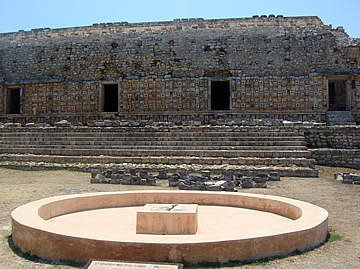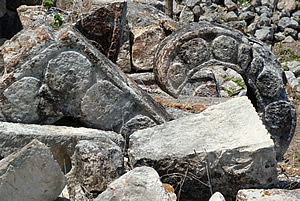

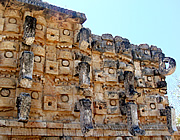
Kabah is famous for the Palace of the Masks covered in stone carvings of the rain god Chaac, but there is much more to this Puuc-style city such as the unique king statues and low relief carved warrior panels.
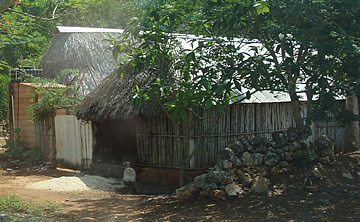
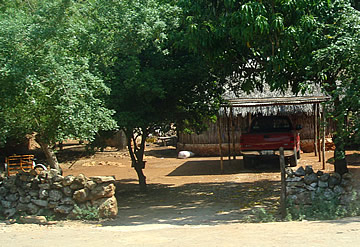
We left Campeche after breakfast with our new guide and driver, Sami, to visit Kabah and Uxmal en route to Merida.
He slowed down at one village to point out typical Mayan-style homes of wood poles lashed with liana and roofed with palm frond thatch.
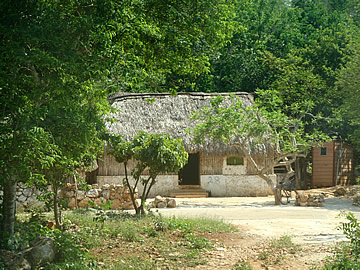
Today the floors of these house are probably finished with cement plaster - the Mayans would have used lime plaster.1 Traditionally there would have been no windows and a centrally placed east-facing door.2
We were accompanied by millions of yellow butterflies for long stretches of the drive.
Kabah is predominantly a Puuc-style site. Puuc, meaning "mountain range" or "hills", refers to the low range of hills running along the north west region of the northern Yucatan peninsula and to the flowering of its particular Mayan architectural style between the 7th and 10th centuries.3

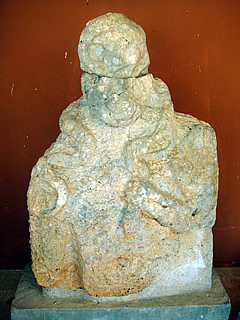
Though there was some kind of settlement at Kabah from as early as 800 B.C. a recognizable town did not exist until around 600 A.D. The city reached its peak between 800 and 1000 A.D. and was later conquered by the Itzas of Chichen Itza before it was abandoned.4 The valleys of the region are fertile and good for agriculture, though water is still a problem and water management systems were needed for both the people and crops.
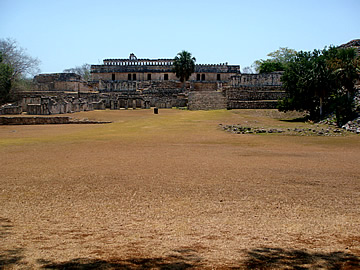
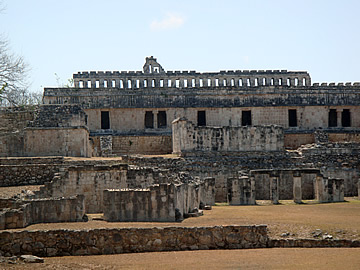
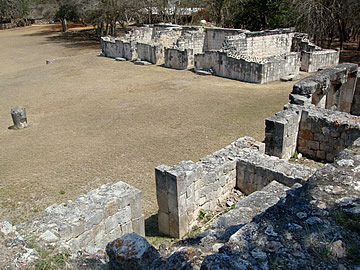
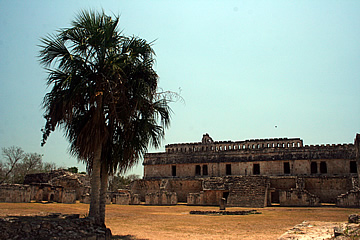
We explored the main group of restored buildings which include the Palace and the Codz Poop with its famous masks. Again we were the only visitors and were free to wander at will.
There is a cylindrical altar in the Lower Plaza and a number of reconstructed rooms on the north side. These are almost mimicked in the higher level Palace Plaza in front of the Palace, though here the altar still stands on a ceremonial platform.
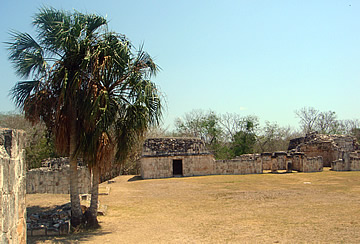
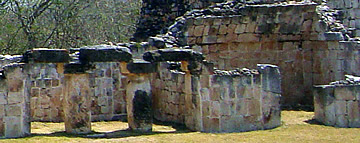
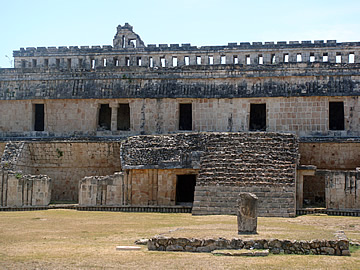
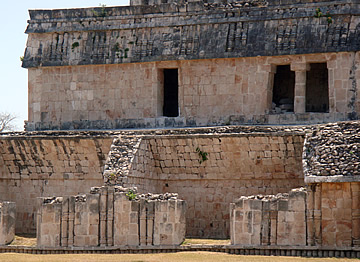
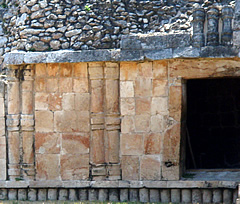
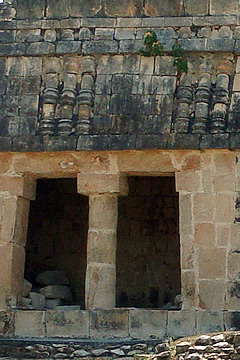
The palace is adorned with a multitude of round columns used both as decorative and structural elements. They all have square capitals in one form or another, a classic Puuc design.
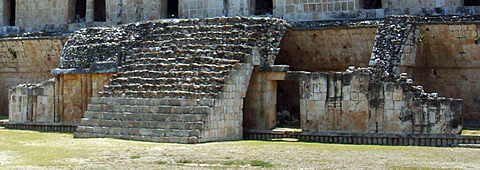
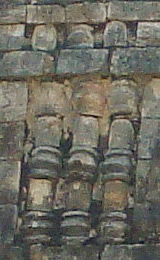
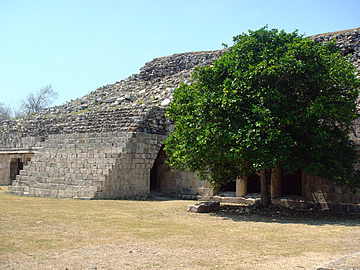
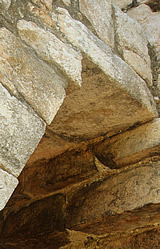
On the south side of Palace Plaza is a part-restored building known as the Elite Residence.
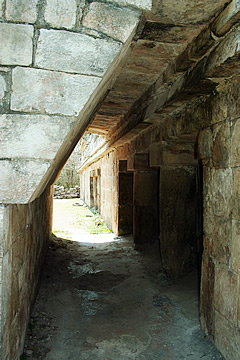
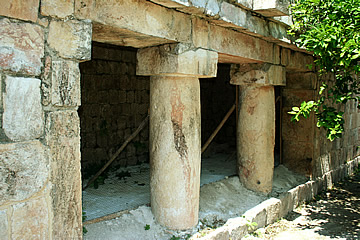

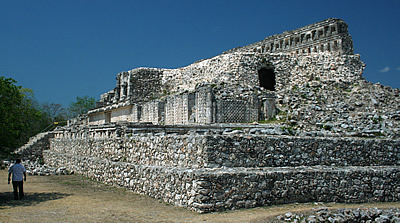
We climbed up to the east side of the Codz Poop to view two remarkable statues set in the facade.
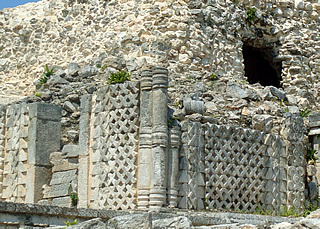

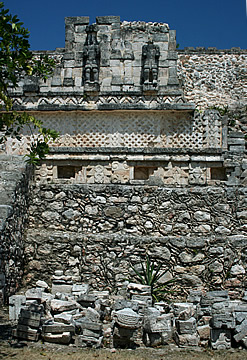
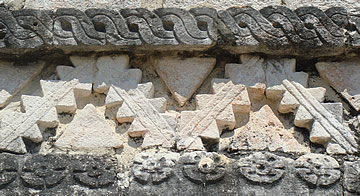

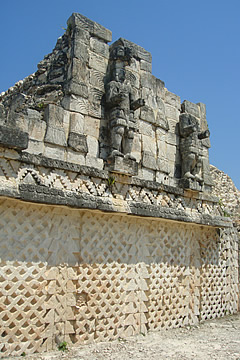
I really liked the geometric stone carving on this facade, and fascinating to see depictions of humans in a statue form - the closest we'd come previously were the almost-three dimensional figures on stele at Quirigua and Copan.
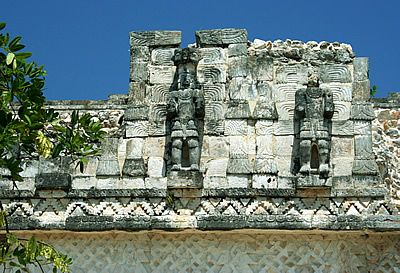
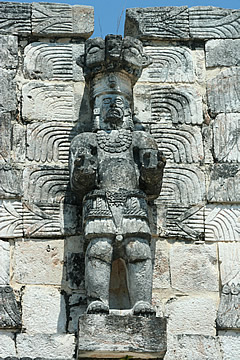
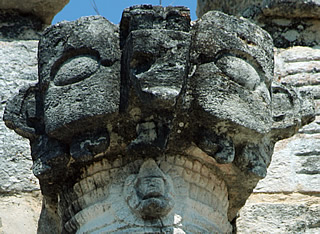
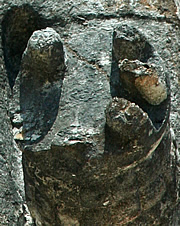
The statues, thought to be of the ruler Kabal, wear a Chaac head-dress - Chaac was the god of rain, a very important deity in such an arid region. Below the Chaac mask a human head emerges from a turtle mouth, perhaps a symbol of birth. The statues have toes and knees and an attempt at hands with fingers but this was a detail too far for these sculptors working without metal tools. The way the arms are bent it's possible the statues were holding something in which case the finish of the hand would not be as important as the structural ability to bear weight.
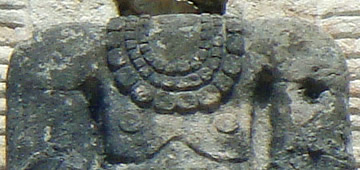
One statue has recognisable breasts and both wear ornate kilts, necklaces and wristbands. Only one has a head and this has curly hair, a moustache, and a tattoo-like feature on its left side. There is another head in the museum in Merida.
It's worth remembering that centuries prior to these Mayan civilisations the Greeks and Romans were creating exquisitely lifelike sculptures. These are much more primitive but fascinating and beautiful in their own way.
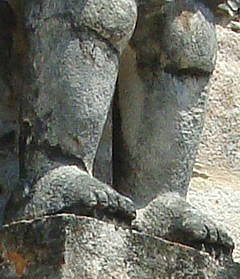
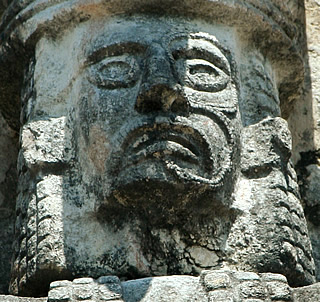
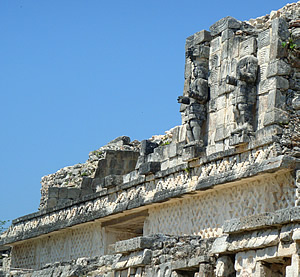
It is fair to assume, I think, that there would have been more of these statues on at least this left part of the building above a wide central doorway which has beautifully carved panels.
Each panel has two carvings, one above the other.
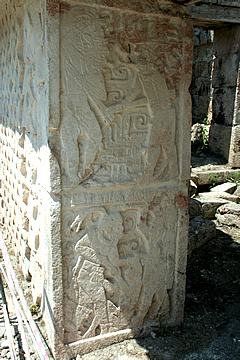
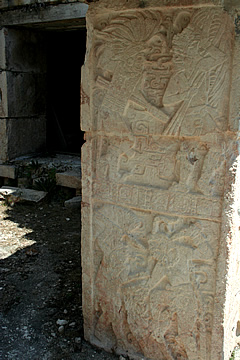
The upper carving on both panels seem to show the same two men fighting. One has an animal head-dress and is possibly a king of Kabah,5 the other with a feather head-dress has similar facial tattooing to the king statue. Both carry bundles of spears and the legs are shown with one foot raised, knee bent, to signify movement.
The lower reliefs both show subjugation of a nude enemy by two warriors. No other known Puuc sculpture shows the elaborate background carved decoration.5
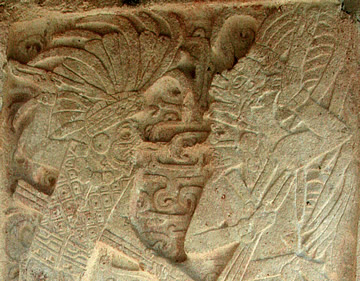
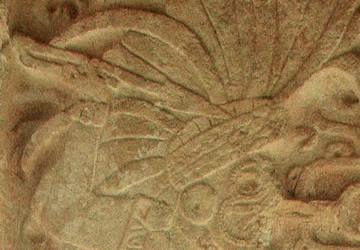
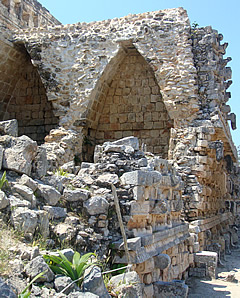
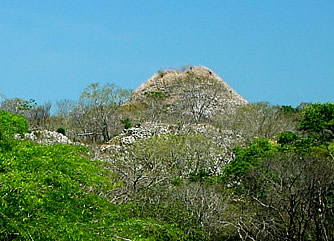
Looking north west from the raised platform a large pyramidal mound can be seen. This is the Great Pyramid, a ziggurat style with stepped platforms surmounted by a temple. Just west of here is a reconstructed free-standing arch which marks the beginning of the sacbe running 18 km north to Uxmal.
We made our way round the side of the Codz Poop to see, finally, the amazing west-facing facade. The image of Chaac is repeated over the whole length, once 260 masks in all, the number of days in the ceremonial calendar - see Quirigua for a brief description of the complex Mayan calendar.

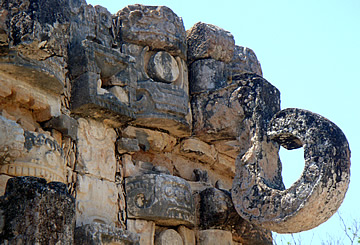
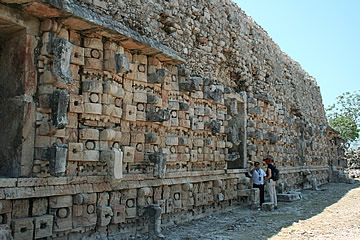
I found this display of masks fascinating, how they must have believed in the power of their gods.
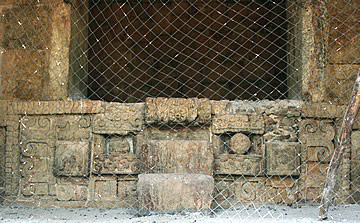
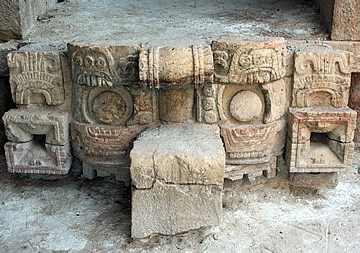
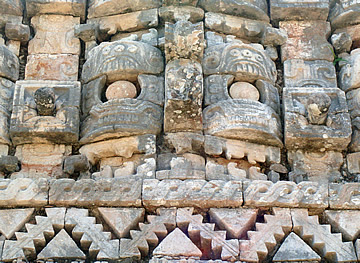
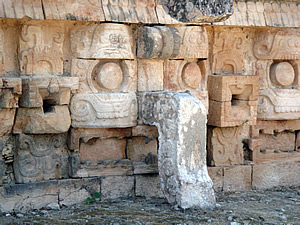
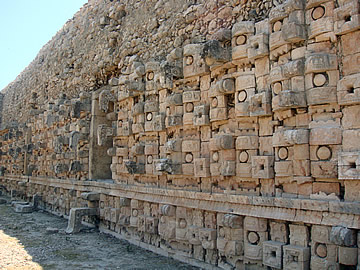
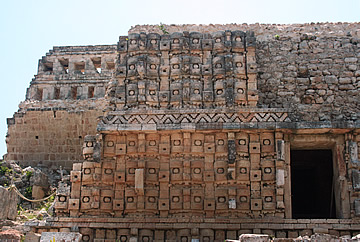
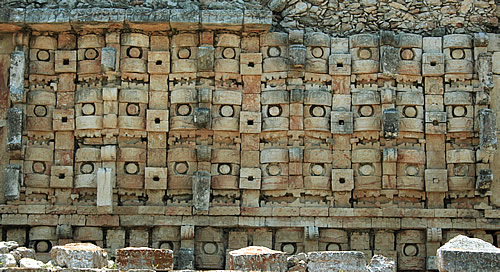
The masks each have eyes, decorated all around, a once-curving snout, and a mouth full of teeth - now jagged but originally curved like a wave. They share ears, once fitted with ornamental plugs.
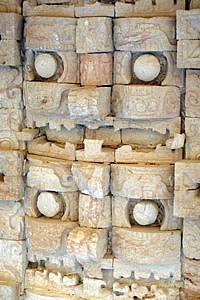
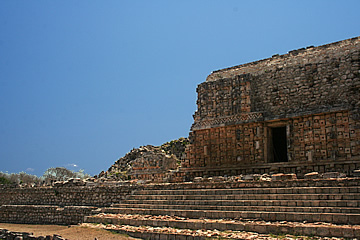
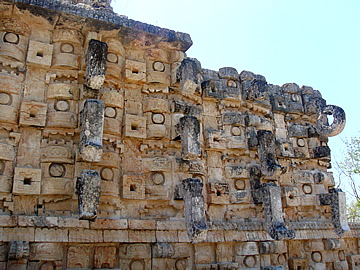
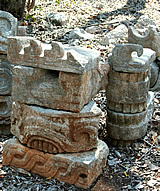
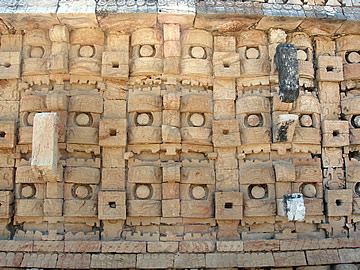
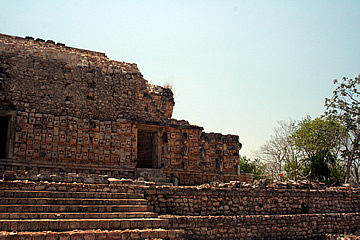
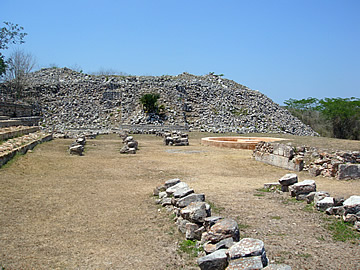
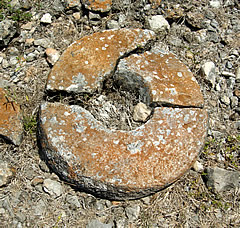
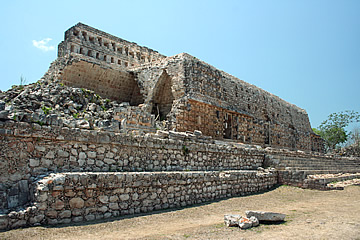
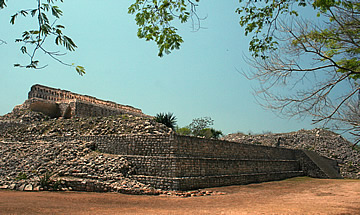
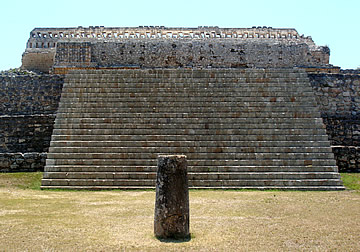
The square Codz Poop altar was carved with glyphs on all four sides, sadly mostly destroyed. Next to it is the restored and fully operational Codz Poop chultun, one of many which would have collected as much rainwater as possible, the only source of water in this arid landscape. I'm not sure why it has a rim - in other sites the surrounding courtyard would slope gently to the entrance to maximise the amount of water collected. It was almost certainly of ritual significance given its location so maybe this has something to do with it. Chultuns were built with narrow entrances to minimise evaporation. Below ground these led to a much wider cavity. A fitting place to leave Kabah - a Mayan site more than any other dedicated to pleasing the great rain god Chaac.
